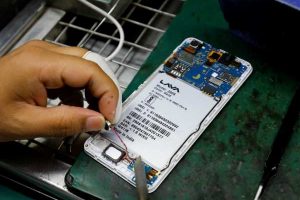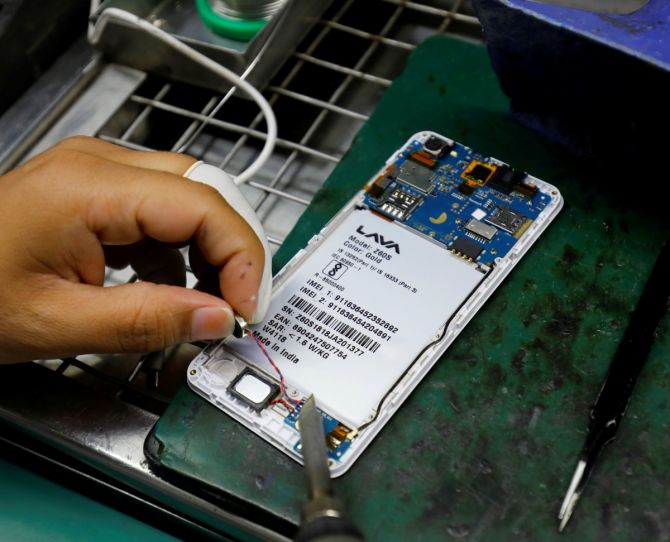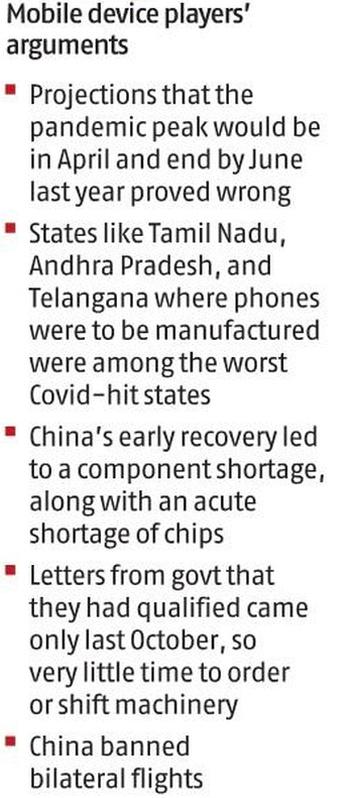Mobile phone makers want relaxation under PLI scheme

In a communication to the empowered committee on PLI recently, the Indian Cellular & Electronics Association (ICEA) has stated that except one player (Samsung), all the other eight players (which include vendors of Apple Inc) selected under the scheme were facing numerous challenges in fulfilling the qualification criteria.
Mobile device manufacturers eligible for the production-linked incentive (PLI) scheme have petitioned the government to invoke the clause of ‘force majeure’ to declare FY2020-21, the first year under the policy, a zero year.
They have cited disruptions due to Covid-19 and the fallout of India-China tensions as reasons for the request.
In a communication to the empowered committee on PLI recently, the Indian Cellular & Electronics Association (ICEA) stated that except one player (Samsung), all the other eight players (which include vendors of Apple Inc) selected under the scheme were facing numerous challenges in fulfilling the qualification criteria.
Under the scheme, each global company has to make incremental sales of Rs 4,000 crore in the first year of the PLI (with each phone with an invoice value of Rs 15,000 and above) and make an investment of Rs 250 crore.
For Indian companies, the incremental sales in the first year are Rs 500 crore and an investment of Rs 50 crore.
The letter has been written to the CEO of the Niti Aayog, secretaries of the ministry of electronics and information technology, expenditure, commerce and industry, revenue and economic affairs, and the Directorate General of Foreign Trade.
Apart from Covid, the ICEA mentions the restrictions on Chinese FDI in India as having significant implications for the ability of PLI companies, which are dependent on Chinese component manufacturers, to move to India and increase value addition.
What’s more, the ban on flights to India, restricted travel of Chinese technicians (as much of the equipment was being shifted from China) and an acute shortage of chips around the world were also cited as factors that have affected companies’ plans and budgets.
The ICEA has pointed out that the government, through an order by the ministry of inance on May 13 last year, had recognised the pandemic as a force majeure event under the category of a public health emergency.
The association points out in its letter that a public health emergency is one of the many events duly recognised under the PLI guidelines under force majeure.
Said Hari Om Rai, chairman of Lava group, which is one of the beneficiaries of the scheme: “We are requesting the government that the first year should be a zero year. We were not able to meet the target due to Covid and the India-China conflict.”
The ICEA suggests an alternative: Shift the scheme by one year so that 2020-21 is treated as the year of preparation with no incentives to be given by the government (the incentive outlay earmarked was Rs 5,334 crore).
Instead, the incentives should start from 2021-22 till the end of 2025-26 (instead of 2024-25 which was the earlier last year).
However, the ICEA wants the incremental investment done in FY2020-21 to be considered in the investment target.
Companies like Wistron and Hon Hai have already exceeded their investment target for the first year.
Mobile device players say that they have had a couple of meetings with the empowered committee on the contentious issue.
“Discussions are on but we are still waiting for a final call,” said a senior executive of one of the mobile manufacturers.
However, Niti Aayog CEO Amitabh Kant, a member of the core group, has said during a seminar on PLIs that the success of the scheme depends precisely on speed of implementation and target-meeting.
The ICEA has also said that companies which have achieved both investment and production targets in FY20-21, due to their ability to exploit existing facilities and production lines and due to having been established in India for a long time, should be given incentives under the scheme.
Samsung, which had already set up a manufacturing facility with large capacity some years ago, has been producing enough phones to be a beneficiary of the incentive.
According to sources, it manufactured over Rs 52,000 crore worth of phones in the country in FY20, out of which some percentage of the revenue came from phones which are over Rs 15,000 per piece.
This contrasts strikingly with other players who are just starting out or had very small capacity operations. And even if they were manufacturing earlier, they were making mostly phones below Rs 15,000 which do not come under the incentive scheme.
Apart from Samsung, the companies which were given clearance under the PLI scheme included three vendors of Apple Inc. which included Hon Hai Precision (Foxconn), Wistron and Pegatron. The other global player was Rising Star (part of Foxconn).
The four Indian companies included Lava, Dixon, Optimus and Bhagwati (Micromax).
Feature Presentation: Rajesh Alva/Rediff.com
Source: Read Full Article


